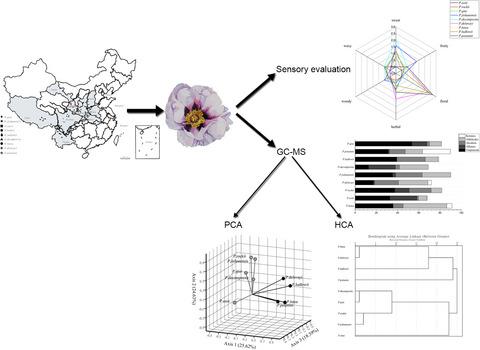当前位置:
X-MOL 学术
›
Flavour Frag. J.
›
论文详情
Our official English website, www.x-mol.net, welcomes your
feedback! (Note: you will need to create a separate account there.)
Variation of floral volatiles and fragrance reveals the phylogenetic relationship among nine wild tree peony species
Flavour and Fragrance Journal ( IF 2.1 ) Pub Date : 2019-12-25 , DOI: 10.1002/ffj.3558 Xiaoning Luo 1 , Meng Yuan 1 , Bingjie Li 1 , Chenyao Li 1 , Yanlong Zhang 1 , Qianqian Shi 1
Flavour and Fragrance Journal ( IF 2.1 ) Pub Date : 2019-12-25 , DOI: 10.1002/ffj.3558 Xiaoning Luo 1 , Meng Yuan 1 , Bingjie Li 1 , Chenyao Li 1 , Yanlong Zhang 1 , Qianqian Shi 1
Affiliation

|
In recent years, more and more attention has been paid to the natural floral volatiles in tree peony and the fragrance components have been widely used in the fields of health care, perfumes, and cosmetics. However, there is little research on the identification of fragrance components of wild tree peony species. In present study, volatile components in petals of nine wild tree peony species were analyzed using a headspace solid‐phase microextraction (SPME) technique coupled with gas chromatography–mass spectrometry (GC‐MS). A total of 124 volatile components were identified and clustered into five major chemical classes: terpenoids, alkanes, alcohols, aldehydes, and ketones. Overall, combined with the sensory evaluation of nine wild tree peony species, Paeonia. ostii (P2) performed herbal and waxy attributes, mainly dominated by hexanal and pentadecane, respectively. P rockii (P1), P qiui (P3), P jishanensis (P4), and P decomposita (P5) all possessed sweet attribute, which was positively correlated with geraniol and citronellol. P delavayi (P9), P lutea (P7), P ludlowii (P8), and P potanini (P6) performed intense floral attribute dominated by linalool and trans‐linalool oxide. Moreover, the results of principal component analysis (PCA) and hierarchical clustering analysis (HCA) showed P decomposita (P5), P qiui (P3), P rockii (P1), P jishanensis (P4), and P ostii (P2) in the Subsect. Vagiatae were mixed to form one cluster while P lutea (P7), P delavayi (P9), P ludlowii (P8), and P potanini (P6) in the Subsect. Delavayanae formed the other cluster. In terms of geographical distribution, the two clusters are consistent with the distribution of wild tree peony species. The present study clarified the relationship between fragrance and components and further revealed the phylogenetic relationship of nine wild tree peony species, thus providing a theoretical basis for their development and utilization.
中文翻译:

花香挥发物和香气的变化揭示了九种野生牡丹物种之间的系统发育关系
近年来,越来越多地关注牡丹中的天然花卉挥发物,并且香料成分已广泛用于医疗保健,香水和化妆品领域。然而,关于野生牡丹的香气成分鉴定的研究很少。在本研究中,使用顶空固相微萃取(SPME)技术结合气相色谱-质谱(GC-MS)分析了9种野生牡丹品种的花瓣中的挥发性成分。总共确定了124种挥发性成分,并将其分为五个主要化学类别:萜类,烷烃,醇,醛和酮。总体而言,结合九种牡丹牡丹的感官评价。ostii(P2)具有草药和蜡质特性,分别主要由己醛和十五烷占主导地位。P rockii(P1),P qiui(P3),P jishanensis(P4)和P decomposita(P5)均具有甜味属性,与香叶醇和香茅醇呈正相关。P delavayi(P9),P lutea(P7),P ludlowii(P8)和P potanini(P6)表现出强烈的花香属性,主要由芳樟醇和反式芳樟醇氧化物构成。此外,主成分分析(PCA)和层次聚类分析(HCA)的结果显示P分解(P5),P qiui(P3),P rockii(P1),鸡山P(P4)和P ostii(P2)。迷迭香混合在一起形成一个簇,而亚科中的P lutea(P7),P delavayi(P9),P。ludlowii(P8)和P potanini(P6)混合在一起。地拉那科形成了另一个簇。从地理分布上看,这两个簇与野生牡丹品种的分布是一致的。本研究阐明了香气与成分之间的关系,并进一步揭示了九种野生牡丹种的系统发生关系,从而为它们的开发利用提供了理论依据。
更新日期:2019-12-25
中文翻译:

花香挥发物和香气的变化揭示了九种野生牡丹物种之间的系统发育关系
近年来,越来越多地关注牡丹中的天然花卉挥发物,并且香料成分已广泛用于医疗保健,香水和化妆品领域。然而,关于野生牡丹的香气成分鉴定的研究很少。在本研究中,使用顶空固相微萃取(SPME)技术结合气相色谱-质谱(GC-MS)分析了9种野生牡丹品种的花瓣中的挥发性成分。总共确定了124种挥发性成分,并将其分为五个主要化学类别:萜类,烷烃,醇,醛和酮。总体而言,结合九种牡丹牡丹的感官评价。ostii(P2)具有草药和蜡质特性,分别主要由己醛和十五烷占主导地位。P rockii(P1),P qiui(P3),P jishanensis(P4)和P decomposita(P5)均具有甜味属性,与香叶醇和香茅醇呈正相关。P delavayi(P9),P lutea(P7),P ludlowii(P8)和P potanini(P6)表现出强烈的花香属性,主要由芳樟醇和反式芳樟醇氧化物构成。此外,主成分分析(PCA)和层次聚类分析(HCA)的结果显示P分解(P5),P qiui(P3),P rockii(P1),鸡山P(P4)和P ostii(P2)。迷迭香混合在一起形成一个簇,而亚科中的P lutea(P7),P delavayi(P9),P。ludlowii(P8)和P potanini(P6)混合在一起。地拉那科形成了另一个簇。从地理分布上看,这两个簇与野生牡丹品种的分布是一致的。本研究阐明了香气与成分之间的关系,并进一步揭示了九种野生牡丹种的系统发生关系,从而为它们的开发利用提供了理论依据。











































 京公网安备 11010802027423号
京公网安备 11010802027423号